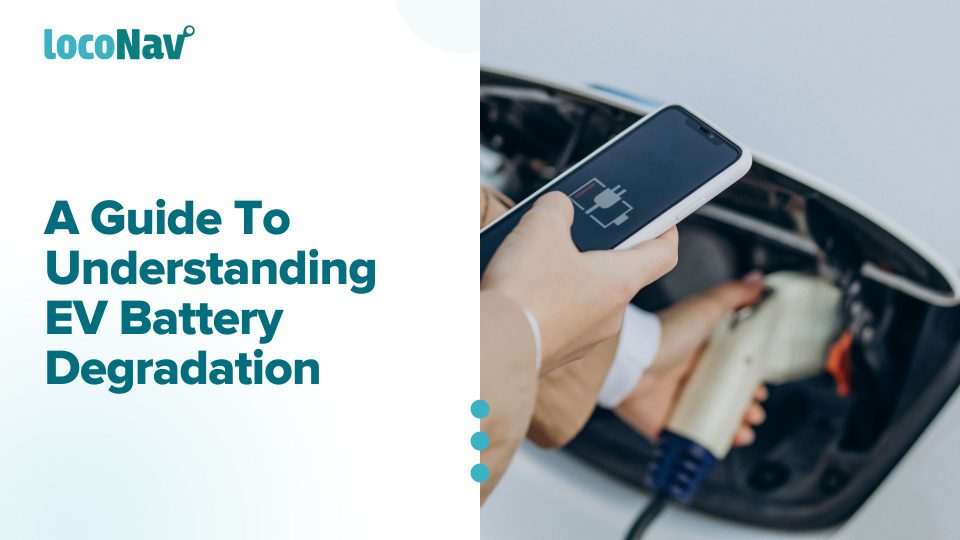

Along with range anxiety and a lack of charging stations, battery degradation is a significant barrier to electric vehicle adoption. Depending on the chemistry, different Lithium batteries have varied life cycles, typically ranging from a few hundred to a few thousand. Due to age, batteries lose their original capacity over this charge cycle, which means the vehicle will not provide as much range as it would on a single charge. Battery Degradation is the measurement of a battery’s capacity decline.
In this blog, we will discuss what electric vehicle battery degradation is, what causes electric vehicle battery degradation, and how it can be prevented.
Manage your fleet efficiently with LocoNav’s Fleet Management Solutions!
What is Electric Vehicle Battery Degradation?
If you have ever had a cell phone, you are probably familiar with the notion of charging cycles. A charging cycle is simply the process of fully charging and then draining the array of cells.
A lithium battery’s maximum charge capacity will diminish after a substantial number of charge cycles. This deterioration process normally begins around 1500 – 2000 cycles for these batteries.
To complete a cycle, the array of cells must charge to 100% and then discharge to 0%. Manufacturers of electric vehicles implement methods to guarantee that the batteries last longer. One of these safeguards is the energy management system, which prevents complete charging and draining, ensuring that the batteries take more time to reach the dangerous cycles.
The batteries’ capacity will eventually degrade due to cycle-aided deterioration. This deterioration is called Electric Vehicle Battery Degradation.
How Does EV Battery Degradation?
Temperature, cycles, and time are the most common causes of EV battery degradation. Temperatures in storage and operation have a serious influence on EV battery longevity; in general, warmer climes reduce the lifespan of an EV battery. The battery gradually loses maximum potential as it goes through charge cycles (discharged while driving and recharged when plugged in). However, merely not using or charging your EV battery does not guarantee its longevity: calendar degradation refers to the battery’s loss of life over time.
Not like the lithium-ion batteries found in phones and laptops, EV batteries use intricate battery management systems (BMS) to control how the batteries are charged and drained in order to extend their life. That indicates that electric vehicle battery degradation is most likely to occur due to temperature or the calendar.
Tips To Prevent Electric Vehicle Battery Degradation
While EV batteries are already long-lasting, owners can take steps to extend their life even more and lower the chance of electric vehicle battery degradation.
#1 Follow Manufacturer Guidelines
To begin, it is critical to follow your EV’s unique battery performance standards, as well as keep your vehicle’s software up to current. Because each EV manufacturer employs a unique combination of battery chemistry and cooling technology, each will have a different set of ideal operating and charging directions.
#2 Do Not Discharge Below 20%
Making sure you do not drive your EV with less than a 20% charge will extend the battery’s life and ensure you always have enough energy to go home.
#3 Only Charge Up To 80%
The range of most EVs is more than enough for everyday commutes and errands, and charging up to 80 per cent is sufficient for a day’s travel. A complete charge to 100% is bad for lithium-ion batteries. With your EV’s onboard charger, you can reduce the maximum charging limit.
#4 Minimise Fast DC Charging
While using direct current rapid charging (DCRC) to charge your vehicle is OK on occasion, if you can reduce the frequency of this charging technique, you will likely notice less battery degradation later in its life.
Fortunately, EV Connect provides a choice of charging stations, ensuring a selection of effective systems for your vehicle. Also, do not be frightened to utilise your EV because regular use has little effect on battery degeneration.
#5 Do Not Drive Too Fast
Moderate acceleration is critical for maximising battery life. Smooth, consistent acceleration will keep the battery charged for longer. This means lesser charging cycles and a lower chance of electric vehicle battery degradation.
#6 Maintain Moderate Temperatures
Lithium-ion batteries perform optimally within the same range of temperatures that people find comfortable. If the weather is too hot or cold for you, it is probably not ideal for your EV. On hot days, park your automobile in the shade and in the garage.
